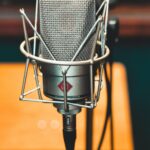Whether it is your first time crossing the threshold into the both where all your dreams lay ahead or not is irrelevant when it comes to picking a microphone. Perhaps you have had thousands of sessions and you have your microphone of choice in mind each and every time. Regardless, there is something warmly and uniquely special about what we do, and whatever your experience level is we work in a space of creativity and exploration. In this article, we will discuss the dynamics between a super cheap microphone and microphones that are worth four digits. But let’s start with a fun fact check, did you know very few voiceover microphones have ever been made? That is correct, almost all the microphones out there were built with musicians at heart, not voice actors. Of course, we do benefit from these fantastic pieces of technology.
Microphones for Voiceover – Cheap or Not?
The truth is you can get a perfectly decent microphone for as little as around $100. You can buy something cheaper than that if you want but two things are going to happen:
- People you work with will wonder why you have this weird microphone no one has ever heard of
- You won’t sound good
In fact, some microphones in the industry have a particularly bad reputation. For example, you would not use the $9 Walmart karaoke microphone to record your professional voiceover, it is just going to sound awful. On the same coin, some of these cheaper microphones were built with podcasters, streamers, and YouTubers in mind – not voice actors.
Microphones Fit for Purpose
So how are our microphones fit for purpose if they were designed traditionally for musicians? well, the simple answer comes in what the microphone is built for. Something accompanying a Twitch stream does not need all the color a professional microphone does. A streamer has loads of crazy things going on from an audible and visual perspective so they really just need to be heard. A musician on the other hand needs every note to count. Every bit of beauty and color needs to be exposed and extracted to make this piece of art its very best. So, from the voice actors’ perspective, what camp better serves what you need? Crazy streaming land or beautiful and wonderful?
The Type of Microphone
Though all musicians don’t use large diagram condenser microphones almost all voice actors do. This is a nice differentiation separating us from the musicians to a degree. You might hear words like ‘Dynamic Microphones’ and such and really this is terminology that is not all that important to you as a voice actor. The industry standard expectation is a large diagram condenser microphone. Does that mean you can not use something different? Sure if you can pull it off. A lot of voice actors use shotgun microphones. But again, can you pull it off? I recommend staying with the industry norm until you really know what you are doing.
Voiceover Microphones Summary
In the next article, we will look a little bit more at the cost difference between microphones. We will also delve deeper into what in-house studios are using and also why a great microphone might not sound good.
Voiceover Microphones by Alan Shires



